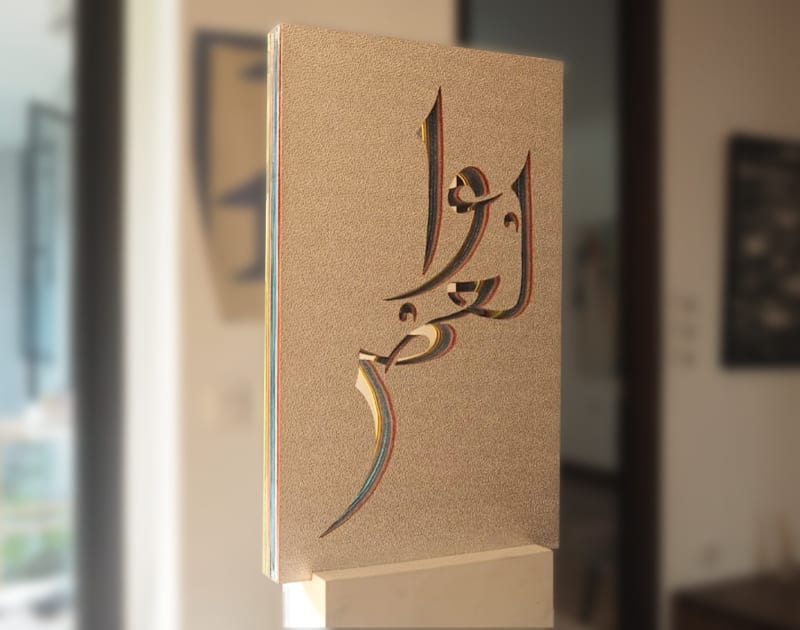Islamic Art Exhibition: The Gift of Looking Inwards
An Exhibition in reference to the lived reality of Islam in Indonesia
In creating an exhibition focusing on self-introspection, we could not separate the identity of Indonesian society from the lasting influence Islamic civilization has on it. In the same fashion, we also could not isolate Indonesia's character from Hindu-Buddhist, animistic, and colonial influences.
This theme was selected to explore the Indonesian Islamic culture in its practical form. In Indonesia, Islam is one of the significant religions that has lived amongst our people, adapted and transformed through thousands of years. Islamic art need not be of a specific stereotypical visual and medium; it is any art that is produced, inspired, and stems from life in a culturally Islamic population. The themes of these artworks discuss the virtue and world-view created from Islamic faith and cultural patterns. It also includes realistic self and societal critique.
The Gift of Looking Inwards poses self-inquisitive questions on how one reflects and interprets their faith in the context of today’s society; in the age of digital disruptions, economic changes, and moral uncertainty. The artworks in this exhibition express Islamic cultural and religious values that are experienced in the day to day reality of life in Indonesia. Featuring prominent and emerging artists such as Arahmaiani, A.D.Pirous, Agus Baqul, Ginanjar Yogie, Mujahidin Nurrahman, Patriot Mukmin, and Rispul.
This exhibition shows that we can find the light of Islam in our hearts, cultures, traditions, and natural environments all around us.
A.D. Pirous is one of the most important figures in Indonesian Art history, setting the stone for future generations of artist s. He merges eastern aesthetic of his Aceh origin with western techniques as inspired by an exhibition of Islamic art at the Metropolitan Museum of Art in the late 1960's. . As seen in his painting ‘Hamparan Hijau di Sisi Laut’ he is adopting western abstraction but the lines in his artworks are not without meaning. Vertical lines in A.D. Pirous's workcould be read as relation between human and the divine, and the horizontal line as relation between human and others.
Although spiritual in nature, his works could always be interpreted openly, as quoted,“(my artworks) ...isn’t da’wah. I’m not campaigning for religion. I am making art. What you see here, all these paintings, these are my spiritual notes.”
The unique way Arahmaiani stylizes her Pegon typographies mean to provide and return the image of Islam from violence and terror post-9/11 back into peace and kindness. The usage of Pegon, the ancient Javanese script also exemplifies the tolerance and openness of Indonesian culture. The presentation of this Arabic calligraphy is rounded and colorful, unlike the stereotype, which the artist hopes to create more conversation and to disprove fears and claims attached to her identity and the majority religion of her nation Indonesia.
Arahmaiani is fascinated by the buried past of her native Java, its rich Hindu-Buddhist cultural heritage – which is now often under-recognized – and the monumental temples that were overgrown for centuries until their rediscovery in more recent times. Indonesia once had vital centers of Bud- dhist learning that were sought out by students from across Asia, including Atisha (982–1054), who became one of Tibet’s most revered lamas.
From the history of Mosque-Cathedral of Córdoba to today’s demolition of Aleppo Mosque, Mujahidin Nurrahman saw a common phenomenon that happens when religion becomes a national ideology. Such ideology could be a justification for regimes to destroy each other. Civilizations overtake one after another; it is built by men and demolished by other men only to be rebuilt and re-destroyed. The world continuously redirected as one sees fit, according to different ideas of what is ‘good’. Chaos, violence, and polemics decorate these in-between periods where revolt occurs.
Patriot Mukmin expresses the sublime feeling that he gets when being submerged in nature, the refreshing breeze and magnificent landscape, the air that he breathes in this artwork. These physical experiences are strung together into a Spiritual Epiphany, unveiling the minuteness of human be- fore the unfolding grandness of nature.
In these moments, Islam recommends phrases for its believer to express these sublime feelings which are ‘Subhanallah’ which means ‘All praise to Allah’ or ‘Maasyaallah’ which means ‘Whatever Allah Wills’. These sentences are visualized in Kufi Calligraphy 36 times in Mukmin’s work, representing the artist’s Tasbih, a Dzikir in Praise of The Almighty.
Demi Waktu’ is an artwork by Rispul, a senior artist lecturing metal-crafts at ISI Yogyakarta. Calligraphic motives often appear in his artworks, as well as references to verses and concepts in Islam. This is because Rispul sees his artworks as an alternative medium for Da’wah, which is teaching through the Islamic point of view. The expression and artwork are intended to remind us of the passing and irreversibility of time. We should not waste our limited time on earth doing deeds without good purpose.
For Yogie Achmad Ginanjar his artworks entitled ‘Tension’ juxtaposes a spaceman against traditional arabesque pattern. These paintings represent the conflict and tension between modernity and Islam. As a Muslim and also an academic, the artist feels this conflict on a highly personal level.
And finally, Agus Baqul’s paintings are full of movement and spontaneity, dynamic and almost abstracted. Unlike the conventional Islamic calligraphy that often employs elements of geometry, repetition, and arabesque his words have raw qualities in them, Agus is careful to write the phrase carefully with exact punctuation and markings because he believes that all Holy Verses given by The Divine should be spread across the world as truthful and faithful as possible.
























